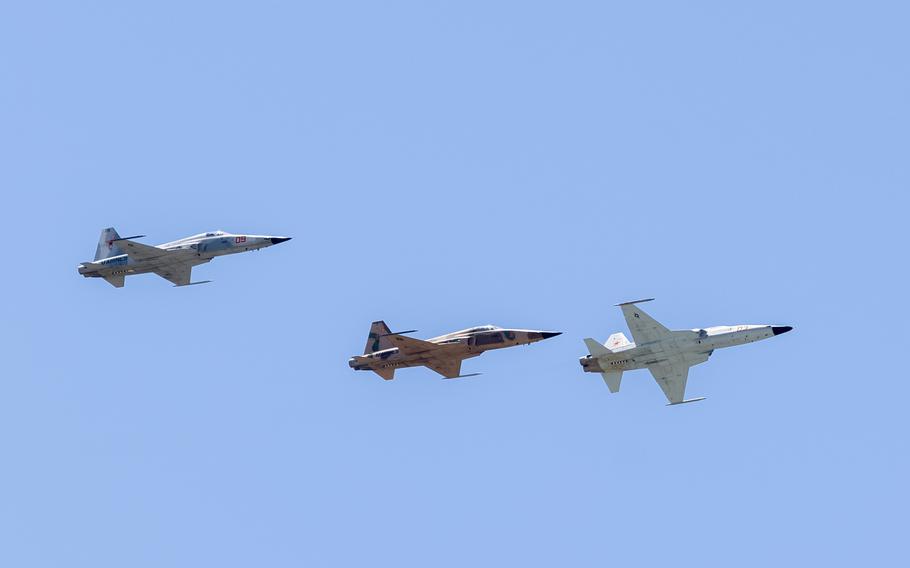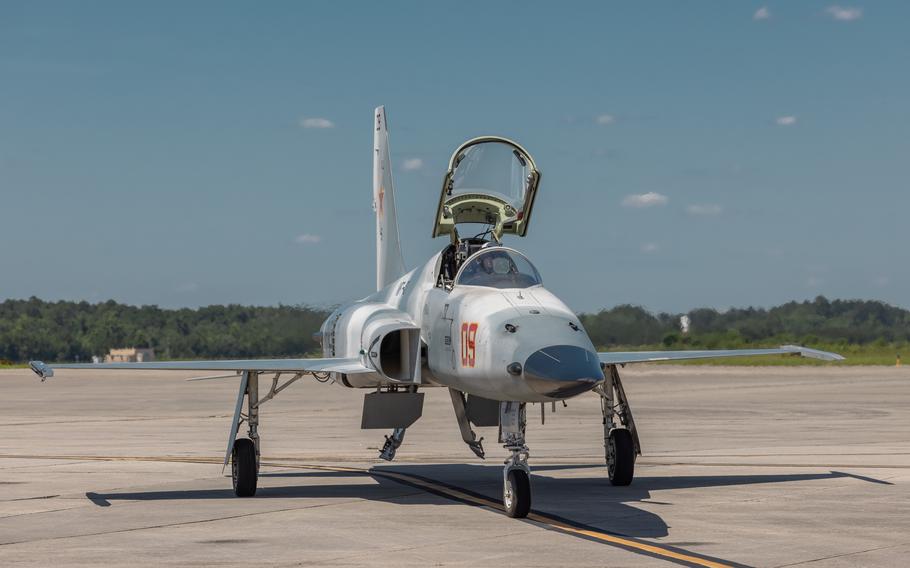
U.S. Marine Corps F-5N Tiger IIs with Marine Fighter Training Squadron (VMFT) 402, Marine Aircraft Group 41, 4th Marine Aircraft Wing, arrive at Marine Corps Air Station Beaufort, S.C., May 30, 2024. (Kyle Baskin/U.S. Marine Corps)
(Tribune News Service) — A new “adversary” squadron of F-5N Tiger II fighter jets — perhaps most widely known for an appearance in a huge Hollywood movie nearly 30 years ago — will soon be sparring with F-35 aircraft pilots who train in the skies up and down the East Coast.
The first three F-5N Tiger IIs arrived May 30 at Marine Corps Air Station (MCAS) Beaufort, where the brand new squadron is providing simulated air-to-air combat training for Marine F-35 pilots to prepare them for “the next high fight” with real foreign enemies.
It’s the first adversary jet fighter squadron based on the East Coast, according to the Marines.
Pilots with adversary squadrons study the tactics and maneuvers of foreign enemies, then employ them in training to create realistic scenarios.
“We have a rapidly growing F-35 fleet, particularly on the East Coast now, and Marine Corps aviation has an insatiable need for as much adversary support and training as they can receive to prepare them for the next fight that’s coming,” said Lt. Col. Andrew Christ, the commanding officer of Marine Fighter Squadron (VMFT) 402, the name of the new adversary squadron.
The squadron currently stands at four but is expected to grow to 10 to 12, Mathis said.
The jets arrived from Yuma, Ariz., where another adversary squadron is based that serves the West Coast, the Marines said. Tiger fighter jets first came out in 1964, with the last aircraft made in 1989, according to manufacturer Northrop Grumman.

A U.S. Marine Corps F-5N Tiger II with Marine Fighter Training Squadron (VMFT) 402, Marine Aircraft Group 41, 4th Marine Aircraft Wing, arrives at Marine Corps Air Station Beaufort, S.C., May 30, 2024. (Kyle Baskin/U.S. Marine Corps)
You’ve probably seen a single seat, twin-engine F-5N Tiger II if you’ve seen the movie “Top Gun.”
In that film, a previous version of the F-5 was painted black and served as the fictional MiG-28 aircraft flown by the enemy. In one of the film’s most memorable scenes, Lt. Pete “Maverick” Mitchell (Cruise) inverts his fighter jet so his aircraft is directly overhead of the MiG and says, “Greetings,” while flipping “the bird” to the enemy pilot. At the same moment, Nick “Goose” Bradshaw (Anthony Edwards) takes a photograph and quips, “watch the birdie!”
Getting the opportunity to pilot a plane so ingrained in popular culture is “kind of cool,” Maj. Erin Mathis, VMFT-402’s operations officer, told the Beaufort Gazette and Island Packet.
But the difference between flying an F5 and a more modern counterpart can’t be understated, said Mathis, a former F-18 pilot who was stationed in Beaufort between 2015-2020. The F-5 is small and under-powered and can be difficult to slow down at times as a result of both factors, Mathis said. Its instruments, he adds, are mostly analogue and sometimes called “steam gauges,” compared to the digital systems of the F-35.
The F-5, Mathis adds, is very reliable and “great to fly.”
“If I can turn the jet on,” Mathis says, “I’m going flying.”
MCAS Beaufort, long known as Fighter Town East, is home to Marine Fighter Attack Training Squadron 501, which is considered the premiere F-35 training squadron on the East Coast.
The VMFT 402 squadron of F-5N Tiger IIs will provide the East Coast with similar training assets that already are available on the West Coast from the other adversary squadron based in Yuma, Marine officials said.
“We’ve needed this capability on the East Coast for a number of years and it can’t come soon enough,” said Christ. “We need to get our house ready for the high fight.”
Having on-station adversary support from the F-5 squadron will will save money because of the lower per-hour costs of flying the aircraft and because its closer to East Coast training ranges, Marines added.
The F-5N Tiger II may be old, but it can still reach Mach 1.6 or 1,227 mph. And the adversary mission is critical in the training of current and future F-35 pilots, Marines say.
“We, as experts in adversary tactics and experts in the way the adversary fights, provide the fleet units with a unique look at basically what the adversary does,” Mathis says.
(c)2024 The Island Packet (Hilton Head, S.C.)
Visit at www.islandpacket.com
Distributed by Tribune Content Agency, LLC.